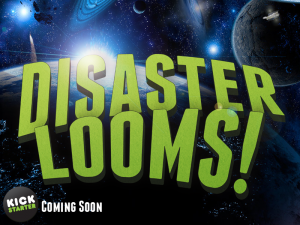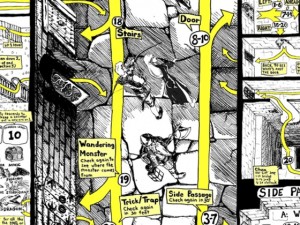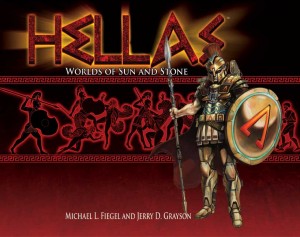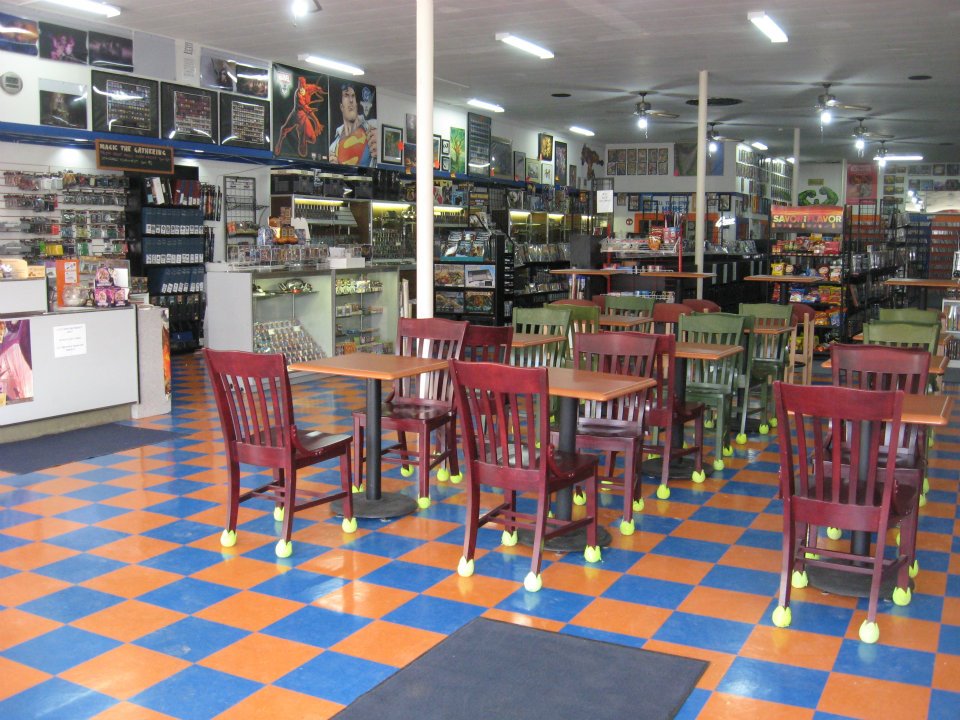GAMA Trade Show Crowdfunding: Kickstarter and Indiegogo
If there was a buzz word at the 2012 Gama Trade Show it was Kickstarter. Kickstarter this, Kickstarter that. It came up at almost every seminar I attended. At the wrap-up round table discussion on Friday at the GTS when an attendee questioned what Kickstarter was the room almost exploded with nerd incredulity. Fortunately someone was very brief in describing it and rival Indiegogo: instead of the artist or designer paying for a project, the fans are able to make contributions as a crowd, hence the term crowdfunding. In fancier terms, it’s a pledge aggregation site. As Anthony from the G.U.B.A.R. podcast said in G.U.B.A.R.’s 9th episode, “If you’re in the gaming community and you haven’t noticed Kickstarter, then you’re not paying attention.”
Before the GAMA Trade Show though, I do have to admit to only having heard the name before and never had actually visited the Kickstarter website. The poster child for Kickstarter at the GTS was the reprint drive for Rich Burlew’s Order of the Stick which was brought up at least four times, as well as the fact that he raised $1.2 million with his campaign. In his Next Generation of RPGs, Jim Crocker introduced the idea of retailers using Kickstarter or Indiegogo to find new bleeding edge games for their customers, referencing the Kickstarter project for Random Dungeon Generator as a Dungeon Map, which raised $27,789, exceeding its $2,000 goal. Crowdfunding is a big deal. At Michael Stackpole’s Social Networking seminar, there was a rehash of what crowdfunding is and how it can benefit retailers. The idea of store owners talking to their players to find out their interests and ordering on their behalf was again brought up enthusiastically. Another possibility offered by crowdfunding is low-cost hardcopy advertisement in products, such as RPG rule books or expansions. Besides acknowledging individual contributors, a thanks or credits page could cite East Side Games for their assistance. Stackpole was also very modest in the brief crowdfunding discussion, not mentioning his own significant involvement in the launch of Wasteland 2 on Kickstarter ($2,933,252 raised with a goal of $900,000). Besides these various mentions of crowdfunding at the GAMA Trade Show, there was an entire unpublicized breakout session on the topic.
The Impromptu Crowdfunding Roundtable
One of the seminars I wandered into turned out to be quite different than what was posted on the sign; it was an impromptu Crowdfunding Roundtable with about two dozen GTS attendees. One of the factors in deciding between Kickstarter and Indiegogo that was being discussed was the need for a US bank for Kickstarter, whereas Indiegogo is more friendly for overseas crowdfunding. Another key difference is what happens with the funds if a project fails to fund. With Kickstarter, none of the contributors are charged, whereas the funds generated on Indiegogo are left to the developer’s discretion. Consequently an important part of developing on Indiegogo is deciding what you will do with the funds if you don’t meet your goal. They will also charge a higher percentage if your project doesn’t fund. Everyone who has conducted a Kickstarter campaign stressed that all of the prep work should be done first for the project and that developers should set realistic goals.
Retailer Scott Thorne shared his experience in using crowdfunding “years before Kickstarter or other forms of online crowdfunding became available.” The problem at his game store, Castle Perilous, was seating. Thorne solicited his customers for donations of $20 to help get new chairs for the store. He offered an inducement of putting each participant’s name on the back of an individual chair. The vanity reward paid off with 20 customers participating and securing the new seating for the store.
Others spoke on crowdsourcing. Vicky Beaver was asked to share her experience with Caladon Falls’s successful funding on Indiegogo and generally agreed with many of the other principles expressed about successful project management described here. Someone shared that less than 1% of project backers fail to make payment when it comes time to fund a successful Kickstarter project, which meshed with a project that was brought up which had secured $12,000 in funding, though one contribution of $5 didn’t come through.
Jon Huston from Troll and Toad contributed that for him the updates are really important. Every Kickstarter that Huston has signed up for has fully funded, he said, including Wasteland 2. As a project moves along its developers can post updates to let fans know how far along from the goal they are, to encourage further advertising, and to keep fans abreast of any changes. The update posts to the Kickstarter project page, but also generates an email to backers. So far on the Hellas RPG reprint Kickstarter there have been 16 updates, with 11 of those before the project met its goal and 5 since then.
The Retail-Friendly Kickstarter Email List
David Wheeler of Dragon’s Lair Comics & Fantasy with stores in Austin, San Antonio, and a franchised store in Bellevue, WA attended the impromptu discussion. He has put together an email list of Kickstarter-friendly retailers, so if you are either developing a game project or are a retailer interested in this list, you can join it by emailing info at dlair.net. As of May 1, there were 47 interested retailers on the list.
Crowdfunding: Not for Everyone
Larry Roznai pointed out one perceived flaw with crowdfunding at the Domestic Manufacturing GTS seminar. Roznai argued that by offering games as rewards on Kickstarter, the manufacturer is bypassing retailers and in his experience, retailers are where manufacturers should be focusing their efforts. He’s not alone in urging caution when it comes to Kickstarter and Indiegogo. One attendee at the impromptu roundtable pointed out that it is deceptively easy to fail on Kickstarter. Failed Kickstarters aren’t advertised or promoted by Kickstarter and a project developer is unlikely to point out past failures. Since no money gets charged from contributors to failed projects, there are seldom any hard feelings, so a contributor is less likely to recall failed projects as well. However, in the exhibit hall later, a manufacturer mentioned that a friend intentionally launched a project, knowing it would fail, as a means of advertising a new product from his company. This is not what Kickstarter is all about and could have hurt the company’s reputation.
Kickstarter Veteran: Impact Miniatures
Tom Anders from Impact Miniatures has successfully funded 4 projects using Kickstarter, with the largest being a $5000 fund for a miniature ape football team. Anders had been approached about making a football team of great apes by a customer, but doubted that it would sell. Rather than dismiss the ape fan outright, Anders offered to put it on Kickstarter. The fan of football playing-primates rallied his friends and kicked in $2,000 of the project himself. The finished figures should be coming out in June. His minor inducements to contribute included a variety of figures, but Anders had two top tier stretch rewards. As Anders explains “stretch rewards are incentives that you offer the people after you’ve hit your goal.” In the case of the Ape Team, these included a customer getting an ape tattoo as one reward, with the other being a sixth sculpt for the primate team. The Apes of Wrath was selected by Kickstarter as a featured project, but only for a day. Anders did see a small spike in contributions while featured in the Top 3, but pointed out that he watches another game designer’s campaigns. When she would advertise being at a convention in her updates, there were much larger spikes in her funding on those convention days than what she got when her project was also featured in the Top 3. Anders agreed that “personal contact drives” Kickstarter.
As for the importance of updates, Anders says they are, “Vital. I have found that the Kickstarters that communicate on at least a bi-weekly basis seem to do much much better than the ones that just throw it out and don’t really let anyone know what’s going on. One of the things that Order of the Stick did so well was that every 2 days he sent out an update to thank everyone, to let them know what he was working on, to let them know what the next stretch reward would be.”
Impact Miniatures will be releasing their next project, Impact City Roller Derby, on Kickstarter with a projected date of May 15. When we talked at the GAMA Trade Show in March, Anders and his team had already come up with 5 different stretch rewards for the roller derby game. He also has already planned ahead to his promotion schedule for the future Kickstarter campaign, planning at least two convention events to help him sell it to potential backers. As for his track record with receiving the pledged funds, in Anders’s experience with the 4 projects, he has received 100% of the pledged funds which are charged through Amazon.com.
Further Kickstarter Advice: Collins Epic Wargames
While at the GAMA Trade Show, besides interviewing Byron Collins about Collins Epic Wargaming’s upcoming 6mm sci-fi rules set Polyversal, I also asked him about Kickstarter and his experience with it. He pointed out that “it’s a great tool, but that’s what it is, a tool. It’s not the end all solution for you as a designer.” C.E.W. first used Kickstarter to fund the Spearpoint 1943 Map Expansion and he plans on crowdfunding again. The Spearpoint ’43 Map Expansion was a 60 day campaign and was a success, receiving over $10,000 for its goal of $7,500, or 135% funding. A key aspect of a successful Kickstarter plan according to Collins is taking the time to come up with excellent rewards for your backers. One prestige level of reward Collins offered was the chance to appear as a character in the game’s stories authored by Mark Walker that will accompany the map expansion. Another tier of rewards was unlocked when the Spearpoint expansion reached $10,000, allowing Collins to include more bonus map tiles, as a stretch reward. Despite the success, Collins has noted areas where he could improve in future campaigns and is willing to share his experience with others designers. As for general advice to game developers on doing their first Kickstarter, Collins suggests:
“If you’re about to launch a Kickstarter campaign and nobody knows who you are, you’re on the wrong path. You need to already be out there, on BoardGameGeek maybe, or at a show doing a demo, not necessarily doing a booth, but go play at open gaming at a convention, get a lot of good feedback on that game, test it really well, make sure it’s done, because a lot of games up there, it’s obvious that they’re not fully developed, they’re not fully hashed out.”
Besides Kickstarters going well, Collins pointed out that they can also fail miserably. It is this binary finite nature of Kickstarter, success or failure, that Collins also seems to enjoy. Either fans want it or they do not. He did have this advice to offer though:
One of the things that I see happening is people who have never dealt with game production before, get into Kickstarter, they raise a ton of money, and all of a sudden, you’re on the hook. You’re on the hook with people’s money and that’s a big deal. If you’re not a business, and you launch a Kickstarter, you’ve got some tax implications. Really, either way. You’ve got to think about a lot of those things. You got to think about how you’re going to use that funding. Do you already have production sources? Do you have a good idea of what your goal really should be? Are you spending money on advertising? What’s going to come out of that funded Kickstarter? Is it going to be depleted immediately by ad money that you’ve spent on BoardGameGeek. I mean, that may be well spent to help it work, but if you’ve spent all your production money from Kickstarter, you’re going to be in debt, really, because you’re on the hook. So when you get on the hook like that, make sure you know what you’re doing. If you don’t know what you’re doing, you don’t have any sources, there’s people in the industry, including myself, that are willing to help because we don’t want to see people making mistakes that take a great idea and end up not making it happen, because I’m a gamer myself. I like to see new great games, I’ve backed a bunch on Kickstarter myself and the good games out there, you can tell the ones that are done well, and you can tell the ones that aren’t quite ready for Kickstarter, so there’s a lot of prep, and there’s a lot of engagement you have to maintain with people who are watching your project.
First Kickstarter from GTS Attendee: Disaster Looms
 I attended several panels and ate with Eric Salyers at the GAMA Trade Show. Also new to the GTS and game manufacturing, he brought his space exploration game Disaster Looms! with him. The game is a boardless board game, using hexagonal playing tiles instead, which I thumbed through at the show. His company Break From Reality games has just launched its Disaster Looms! Kickstarter campaign with a goal of raising $25,000. His team at Break From Reality Games is getting the word out via Facebook ads and updates, BoardGameGeek ads and updates, in-store demos, and Kickstarter itself.
I attended several panels and ate with Eric Salyers at the GAMA Trade Show. Also new to the GTS and game manufacturing, he brought his space exploration game Disaster Looms! with him. The game is a boardless board game, using hexagonal playing tiles instead, which I thumbed through at the show. His company Break From Reality games has just launched its Disaster Looms! Kickstarter campaign with a goal of raising $25,000. His team at Break From Reality Games is getting the word out via Facebook ads and updates, BoardGameGeek ads and updates, in-store demos, and Kickstarter itself.
Disaster Looms! is offering at least two tiers of retailer-only awards, because, in Salyers’s words, “game stores are the back-bone of our industry” as well as being “the nexus of our community.” Several of Disaster Looms! rewards include in-store game promotion from the Break From Reality team. As he sees it, “I am in this for the long-haul, and plan to release other game titles, and expansions – I need to have an alliance with the game store owner as early as possible.”
Salyers is no stranger to Kickstarter having funded 18 projects so far. He points to The Present as both the first Kickstarter he helped fund and as an inspiration for him as a creator. Salyers actually created Disaster Looms! the night he watched The Present. He also has funded several TMG titles due to his love of “great game play and creatives themes.”
As for stretch rewards, Salyers and his team at Break From Reality have given it a lot of thought:
Our team had rewards chosen all the way to $125,000 funding level. We have released the $32,500 level, and the $40,000 level. We have hinted that there is a $55k+ level as well. We are sitting at 23% funded after 3 days … and we know of a couple thousand in commitments to come. So we are feeling happy, though still stressed about whether we will make our goal. And in particular – we really want to hit the $40,000 level of funding so we can release the game as a 2-6 player game. We really wanted to do this from the outset, but it too high of a goal to start off with for an unknown company with an unknown IP [Intellectual Property]. Stretch goals to us are all about rewarding backers, and creating rewards that will be really appreciated by our backers. We spent literally weeks on the design, testing, and validation of what we wanted as stretch goals. It would not be good enough to throw in branded items that would be of no value or real relation to the game play experience. We think the first player token will enhance the play value of the game, and make the bidding process for the token a little more worthwhile each turn. A heavy sculpted coin is fun to fiddle with. Everyone knows it. The 5-6 player expansion, a true expansion mind you, will add not just 2 more players – but more game content. It will add additional replay-ability to the 2-4 player game as well!
The Disaster Looms! Kickstarter will end its run on June 18. According to Salyers, the Kickstarter process is “a very straight forward system” and he’s had no problems or confusion along the way. Like Byron Collins, Salyers also enjoys the finality of the Kickstarter approach: “you have created something, and now you are sending it out to the world to be accepted or denied.”
This “do or die” feature of crowdfunding is also one of its great strengths and one of the reasons the game industry has begun shifting. Instead of conducting market research or trusting a gut instinct or experience when it comes to whether a game will sell or not, even established companies can vet new products and projects on Kickstarter or Indiegogo and actually know whether they might have a winner on their hands. While there are a few complications and problems to this approach of game marketing, overall the effect on the industry should be a great one.
Disaster Looms! box art is copyright Break From Reality, Hellas cover is copyright Khepera Publishing, and the Spearpoint 1943 Bunker Tile is copyright Collins Epic Wargaming, all used with permission.





Pingback:Video Game Testing Jobs New York | Games Testing Ground
Pingback:2013 GAMA Trade Show Exhibitors’ Hall: Impact Miniatures | Craven Games: In-Depth Tabletop Games and LARPing Coverage
Pingback:» Craven Games Report on GTS - GameBugle